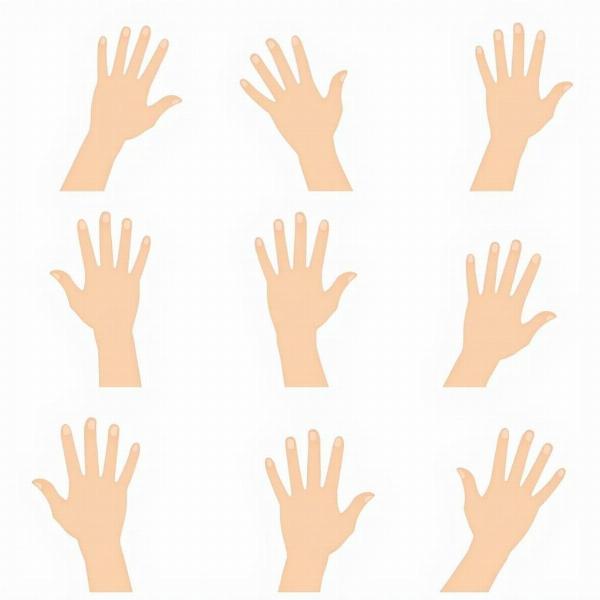Understanding the nuances of “waving ka hindi meaning” can be tricky, especially for non-native speakers. This article delves deep into the various Hindi translations of “waving,” exploring their contextual usage, cultural significance, and common scenarios where they apply. We’ll cover everything from formal greetings to casual farewells, ensuring you grasp the subtle differences and use the right word at the right time.
Different Ways to Say “Waving” in Hindi
The Hindi translation of “waving” isn’t a simple one-to-one correspondence. It depends heavily on the context and the specific type of waving action being described. Let’s explore some common Hindi words and phrases used to express waving:
-
Hath hilana (हाथ हिलाना): This is the most common and versatile translation of “waving.” It literally means “to move the hand” and can be used in various situations, from greeting someone to saying goodbye.
-
Abhivadan karna (अभिवादन करना): This term is more formal and often implies a respectful greeting, such as waving to an elder or a person of authority.
-
Alvida kehna (अलविदा कहना) (while waving): While “alvida kehna” literally means “to say goodbye,” when accompanied by a waving action, it specifically refers to waving goodbye.
-
Ishara karna (इशारा करना): This translates to “to gesture” and can encompass various hand movements, including waving. It’s often used when waving to get someone’s attention.
 Waving Hand in India
Waving Hand in India
Cultural Context of Waving in India
Waving in India, like many other gestures, is imbued with cultural significance. While a simple wave might seem universally understood, the context and manner of waving can convey different messages. For example, a gentle wave with a slight bow of the head is a sign of respect, particularly towards elders. Vigorous waving is often associated with excitement and enthusiasm, while a subtle wave might indicate acknowledgement. Understanding these nuances is crucial for navigating social interactions in India.
Common Scenarios for Waving in India
-
Greetings: Waving is a common way to greet friends and acquaintances, especially from a distance.
-
Farewells: Waving goodbye is a standard practice in India, whether departing from a train station, a social gathering, or simply leaving a friend’s house. You might also see people waving from moving vehicles.
-
Getting Attention: Waving is used to attract someone’s attention, particularly in crowded places.
-
Showing Appreciation: Waving can also be a way to express gratitude or acknowledgement, such as waving to a driver who gave way or to a performer after a show.
Waving in Hindi: Formal vs. Informal
Just as in English, the context dictates the appropriate way to wave in Hindi. In formal settings, a respectful nod accompanied by a gentle wave is preferred. In informal situations, a more relaxed and enthusiastic wave is acceptable. For example, you would likely wave more enthusiastically to a close friend than to a senior colleague.
Conclusion
Understanding “waving ka hindi meaning” goes beyond simply knowing the translation. It involves appreciating the cultural context, recognizing the various forms of waving, and using the appropriate gesture for the situation. This comprehensive guide provides the knowledge and insights you need to communicate effectively and respectfully using this common non-verbal cue in India. So, next time you’re in India, wave confidently, knowing you’re using the right gesture in the right way.
FAQ
- What is the most common Hindi word for waving? The most common Hindi word for waving is “hath hilana” (हाथ हिलाना).
- How do you say “wave goodbye” in Hindi? You can say “alvida kehna” (अलविदा कहना) while waving your hand.
- Is waving considered respectful in Indian culture? Yes, waving can be a sign of respect, especially when accompanied by a slight bow of the head.
- Are there different ways to wave in India? Yes, the manner and context of waving can convey different messages, from formal greetings to casual farewells.
- Is it common to wave in India? Yes, waving is a common practice in India for greetings, farewells, and getting attention.
- What does “ishara karna” mean? “Ishara karna” (इशारा करना) means “to gesture” and can include waving.
- How do I wave respectfully to an elder in India? A gentle wave with a slight bow of the head is a respectful way to wave to an elder.
About Meaning-Hindi.in
Meaning-Hindi.in is your one-stop solution for all your Hindi translation needs. We offer a wide range of professional translation services, including business and commercial document translation, certified and legal document translation, technical and user manual translation, website and localization services, educational and academic document translation, and express translation services. We pride ourselves on providing accurate, culturally sensitive, and high-quality translations. Contact us today for all your Hindi translation requirements! Email: [email protected], Phone: +91 11-4502-7584. Need to say goodbye in Hindi? Check out our article on say goodbye meaning in hindi. For understanding “way up” in Hindi, visit our page on way up meaning in hindi. You might also be interested in hindi meaning of waving or meaning of flap in hindi for related vocabulary. Explore more at Meaning-Hindi.in.